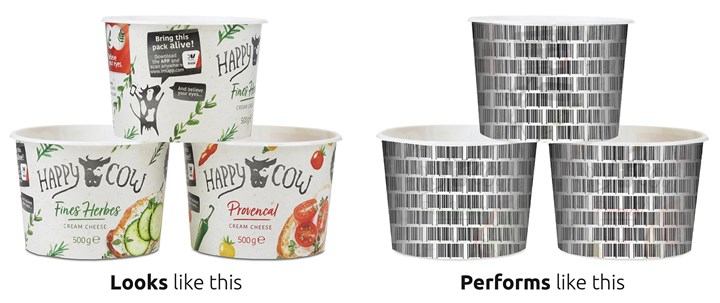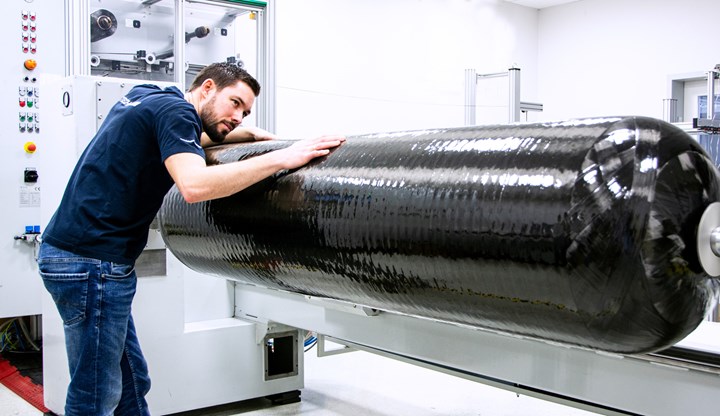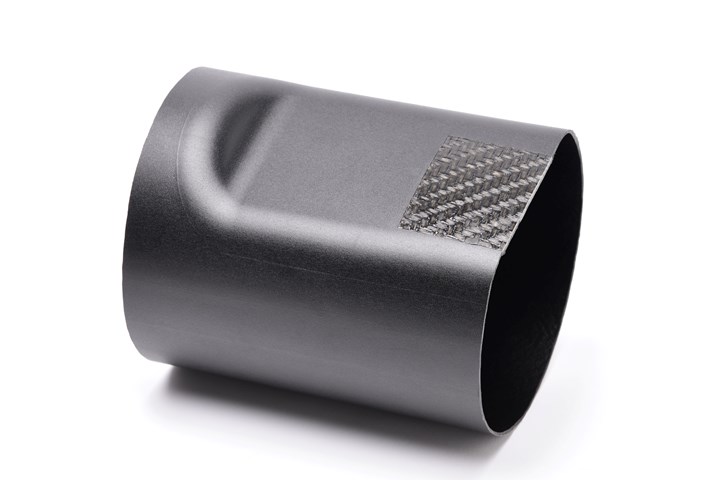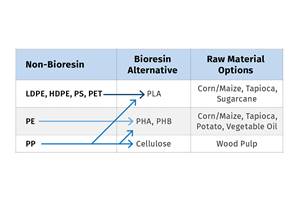20 Good Things to Come Out of 2020—Part 4
Good news was there if you knew where to look for it—in the pages of Plastics Technology magazine or right here on our website. Here’s a review of headlines you can feel good about.
Yes, there was some good news in a year many of us would like to forget. I’m talking about the many signs of a lively stream of innovation flowing beneath the surface slush of economic stagnation—advances and inventions and entrepreneurial resourcefulness that hold promise for a surge of positive developments in the not-distant future. To spread what I hope may be an uplifting end-of-year message, here’s a big handful of my personal picks from the past year’s reporting by the entire staff of Plastics Technology. They’re organized under six major headings:

Plastics were the “good guys” in the response to the COVID-19 pandemic. The industry leaped with unprecedented speed into production of PPE, test kits, sanitizer dispensers and other essential products. (Photo: Milliken)
1. Plastics ‘Manufacturing Heroes’ in the COVID-19 Fight
First, I take some vicarious pride in the alacrity and inventiveness with which our entire industry responded to the crisis and challenge of the coronavirus pandemic. Processors broke all speed records in creating new tooling and switching production virtually overnight to produce personal protective equipment (PPE) and components for COVID-19 test kits and lifesaving medical equipment such as ventilators. Equipment suppliers joined that effort by pressing their lab equipment into service as PPE production machines; and material suppliers shifted some chemical process lines to making hand sanitizer. Many of these products were donated to hospitals and other facilities for free or at cost. Search our site for COVID-19 stories and you’ll find 25 pages of results.
• Here’s just one of these hundreds of stories that sticks with me as an example of how an emergency can prompt innovation. One custom injection molder and moldmaker, Harbec Plastics in upstate New York, took this opportunity to “try out some things that we had been wanting to do but were too busy.” In this case, that meant 3D printing an aluminum tool for face masks, so as to incorporate conformal cooling.
• In case average consumers needed a staggering health crisis to remind them of the many essential roles of plastics, the looming shortage of specialty glass vials for the new antiviral vaccines provided another opportunity. We wrote about filling that gap with vials molded of Topas COC or the new Honeywell Aclar Edge multilayer bottles with PCTFE moisture barrier.
2. Processors Are ‘Going Green’
Apart from the industry’s COVID-19 response, our reporting this past year was full of evidence that plastics manufacturers could be the “good guys” in other ways. We published a whole supplemental issue in May with five features on how plastics processors and brand owners are “stepping up” to meet mounting consumer demand for recycled materials in everything from consumer packaging to car parts.
• But every issue of PT this past year showed evidence of the industry’s commitment to recycling. Among those that stand out for me are ones addressing areas of particular need, such as the formation of a Polypropylene Recycling Coalition to exploit this supremely useful but sadly under-utilized materials resource. (Incidentally, it will no doubt enhance “circularity” of plastics as newer enhanced “performance polypropylenes” close the gap with nylons and polycarbonate in engineering applications, as reported by Lilli Sherman in the September cover story.
• Senior Editor Heather Caliendo also reported on hotbeds of activity (such as Ineos and Eastman) in developing chemical recycling to utilize hard-to-recycle mixed plastics waste and to produce high-purity, just-like-virgin materials with potentially greater efficiency and cost-effectiveness than mechanical recycling methods (see here, here, here, here, here and here).
• I also consider it an encouraging trend that more and more additives are being developed to improve the properties of recycled/reprocessed plastics. Senior Editor Lilli Sherman covered recent advances in this field by Britec Solutions, Sukano, Aquadye Fibers and Riverdale Global.

Plastics showed their “green” credentials in 2020, such as with the “Holy Grail 2.0” project to improve sortation of mixed plastics in recycling through the “invisible” watermarks of the Holy Grail 2.0” project. (Photo: Verstraete)
• And I’m encouraged by a novel product-identification technology that can allow packaging labels, or the plastic objects themselves, to be printed with an “invisible” watermark that reportedly can make a quantum leap in automated sorting efficiency on recycling lines. Since separating mixed plastics is one of the greatest technical obstacles to recycling, this watermarking technique has been dubbed, enthusiastically, “Holy Grail 2.0.”
• Plastics are going “green” in other ways, as well. Renewable, biobased plastics continue to make headway, despite obstacles of cost, availability, processability, and performance limitations. I was glad to see that both Borealis and SABIC have pioneered a renewable feedstock route to polypropylene, as was previously achieved for polyethylene.
• Learning how to process bioplastics is still an unfinished journey; so, I couldn’t help being intrigued Nissei’s technique for injection molding with supercritical CO2 to enhance flow of PLA biopolymer in very thin sections without any sign of bubbles to cloud the resin’s high transparency.
• Apart from PLA, success stories for biopolymers have been relatively few. Hooray, then, for Bacardi rum, which plans to roll out a full-sized liquor bottle in Danimer Scientific’s Nodax PHA, though we’ll have to wait until 2023 to lift a toast. If that succeeds, then we’re told to look for biopolymer bottles for Bacardi’s other brands—Bombay Sapphire gin, Grey Goose vodka, Patron tequila, Martini vermouth and Dewar’s scotch.
• As was abundantly evident at the K 2019 show, and no doubt will be at NPE2021, sustainable plastics processing is coming into tighter focus. Making greater use of recycled plastics and renewably sourced plastics are two themes; others are lightweighting, energy savings, and scrap reduction. As was reported in our August issue, all of these capabilities are represented in one relatively new and intriguing technology for constant low-pressure injection molding, known as iMFLUX.
3. Processors Are Also Going ‘Additive’
Besides the “green scene,” another big trend in plastics and manufacturing generally is toward additive manufacturing (AM), otherwise known as 3D printing. Here are some highlights:
• Boosting the strength and heat resistance of 3D-printed parts is a goal for demanding applications such as plastics molds. Arburg announced a system for continuously adding programmed amounts and lengths of glass or carbon fibers for locally reinforcing parts built in its Freeformer printing system. With a focus on plastics tooling, Fortify can run reinforcing fibers or ceramic microparticles in its liquid AM systems. And Essentium is a young Texas company focused on proprietary materials and printing systems for functional, structural AM parts. One of its key technologies involves coating and fusing carbon nanotube reinforcements onto 3D printing filaments.
• As noted in the Harbec example above, AM holds barely tapped potential for plastics molds—made of metal. One of the most promising developments of the past year in this vein was Hasco’s introduction of 3D-printed hot-runner manifolds with geometries unimaginable with conventional machining.
• Injection molders are gradually adopting 3D printing of plastic parts as a business extension, allowing them to compete for very short runs, very short lead times, and complex designs that would be impractical (or impossible) to injection mold. Protolabs in Minnesota has probably taken this model farther than any other injection molding firm. New entries include EVCO Plastics in Wisconsin and Makuta in Indiana.

New technology from Addifab could represent a “perfect marriage” of injection molding and 3D printing.
• What might be termed the “perfect marriage” of injection molding and 3D printing was introduced to North America by Addifab of Denmark. Using its equipment and liquid photopolymer materials, a molder can print cavity inserts, place them in an injection mold base, injection mold them with almost any type of resin (even LSR), then remove the insert and dissolve away the printed shell to leave only the injection molded component. Addifab says its market is injection molding, not 3D printing.
• Given its rapid growth, it’s encouraging to see signs of 3D printing joining the trend to “circularity.” Covestro recently exhibited AM parts printed with recycle content.
• It’s also an encouraging sign that a professional development certificate program for 3D printing has been launched at Texas A&M University in collaboration with EOS.
4. Machines Are Getting Smarter
A third huge trend that bodes well for the future of plastics is “smart factories,” the “internet of things,” or Industry 4.0. My favorite headlines of the past year:
• Wittmann Battenfeld has made OPC-UA, the de facto communication standard for the 4.0 world, standard on all its network-compatible auxiliary equipment. All those auxiliaries can now integrate with B8 controllers on Wittmann Battenfeld injection presses. For small plants that don’t have a central computer hub connected to all plant activities, Wittmann Battenfeld introduced a data reporting and analysis system called TEMIone, a “one-machine MES” with a server inside the machine control cabinet that collects production data from the press and all cell peripherals.

Smarter machines: A trend to watch is integration of mold-filling simulation with injection molding process control. (Photo: Engel)
• How smart a granulator do you need? In the 4.0 future, the answer may be “pretty smart.” A preview of what that could mean is provided by Hellweg Machinenbau of Germany, which offers grinders with GRANUmaster touchscreen control, equipped with OPC UA to communicate upstream and downstream for production monitoring and predictive maintenance planning, as well as smart controls that learn the optimum speed and torque settings for current conditions, and complete onboard maintenance manuals with step-by-step instructions. These choppers can even order spare parts.
• Wittmann Battenfeld has held a unique position in that it makes both injection presses and a wide range of auxiliaries, which can be linked together via the company’s Wittmann 4.0 networking scheme. More recently a number of other injection press makers are launching integrated cell-level control/monitoring systems, but theirs are intended to network peripherals from a variety of other suppliers. Arburg has been working in this direction with its ALS computer system for some time. Engel recently joined the ADAMOS (Adaptive Manufacturing Open Solutions) consortium, which developed the ADAMOS Hub software for cell integration. And broadening this trend beyond Europe and the Americas, Nissei of Japan introduced its N-Constellation for cell integration, based on Euromap protocols.
• When it comes to making machines and processes smarter, a fascinating trend to watch is efforts to integrate mold-filling analysis with injection molding process control. Arburg, Engel, Sumitomo (SHI) Demag and Wittmann Battenfeld are all working on this.
• For quite some time now, molders have used injection process monitoring to determine whether critical variables such as injection transfer point or cavity pressure at end of fill keep within SPC limits and segregate any out-of-limits shots as possible rejects. But it would be a real step forward if process monitoring could actually predict part quality in terms of dimensions or strength—providing automated QC without time-consuming metrology tests. That’s just what Kistler promises with its new artificial-intelligence (AI) powered ComoNeo Predict software.
• Injection molding machines will not be truly smart until the industry manages to illuminate one of the remaining dark corners of this process. A number of companies have been working to unravel the mystery of melt temperature in molding; two, in particular, have come out with original approaches that have attracted considerable attention. Check out these developments from Md Plastics and Procon Training and Consulting.
• The ultimate goal of Industry 4.0 is fully autonomous processing without human intervention. But mention “lights-out” processing, and most people will think that’s beyond the capital budgets and technical know-how of all but very large companies. That’s why I’m encouraged by two stories we ran this year on rather small molders that are running lights-out for years. Senior Editor Tony Deligio profiled Medical Components of America in Texas, which has only six injection machines and 10 employees and runs unattended 50-60% of each day. And I interviewed family-owned T&M Enterprises in Vermont, with 16 machines and eight people, which runs lights-out on the third shift.
• An essential consideration when networking machines and processes is safety. It’s therefore encouraging that the first international ISO safety standard for injection machines was published last spring.
• An important, but perhaps easily overlooked, step forward for plant integration was the formation in August of a working group of 25 member companies to extend Industry 4.0 to laboratory test equipment. The idea is to create a standard protocol for such devices to interact with laboratory information management systems (LIMS) and ERP systems for sample tracking, data and document management, predictive maintenance, and process monitoring and control.
5. Enhanced Flexibility in Machinery Acquisition
First, one lesson learned from the COVID-19 experience is the virtue of being light on your feet in an unpredictable world, able to change directions and pursue new markets and applications on short notice. Among the recent initiatives by machine builders to cut lead times and reduce the capital risk in pursuing new ventures are these:
• Arburg launched online ordering and configuration with one 35-ton model of injection press having a specified range of modular options.
• Milacron announced last summer a rental option for new machinery, together with its Quick Delivery option. The immediate goal was to allow processors to temporarily boost production of items to aid in the fight against COVID-19.
• Engel recently started offering used and reconditioned robots and molding machines on a global basis. KraussMaffei has been doing this for a few years.
6. Blow Molding Innovation
Although most of what I’ve listed so far applies mainly to injection molding, I can’t close without mentioning a couple of noteworthy advances in blow molding:

Breaking barriers for engineered blow molding: 320-liter hydrogen fuel-tank liners in nylon. (Photo: Kautex)
• Blow molding engineering resins like nylons has always been a challenge. All the more impressive, then, that Kautex managed to blow mold 320-liter hydrogen fuel-tank liners in a special nylon. Measuring more than 2 meters long and around 500 mm in diam., the tanks were blown on an accumulator-head machine.

Blow molding may have a role in lightweight, high-strength composites for automotive. (Photo: Lanxess)
• High-strength, lightweight thermoplastic composites for structural parts have been a focus of injection molding R&D in recent years—and now also in blow molding. As in injection molding, the focus is automotive applications, the material is typically nylon 6 or 66, and the technique involves selective placement of preheated continuous-fiber thermoplastic prepregs (“organosheets”) in the open mold (in this case, while the parison is being extruded). Developed by Lanxess, the innovation here is a one-step process, more efficient than prior methods of welding flat or preformed organosheets onto the part after molding.
Read more:
20 Good Things to Come Out of 2020—Part 1
20 Good Things to Come Out of 2020—Part 2
20 Good Things to Come Out of 2020—Part 3
20 Good Things to Come Out of 2020—Part 5
Related Content
Resins & Additives for Sustainability in Vehicles, Electronics, Packaging & Medical
Material suppliers have been stepping up with resins and additives for the ‘circular economy,’ ranging from mechanically or chemically recycled to biobased content.
Read MoreHow to Optimize Your Molds and Hot Runners for Processing Bioresins
Demand for bioresins is growing in molded goods, particularly as a sustainability play to replace fossil-fuel based materials, but these materials are not a drop-in replacement for traditional materials. Molds and hot runners need to be optimized for these materials.
Read More50 Years of Headlines … Almost
I was lucky to get an early look at many of the past half-century’s exciting developments in plastics. Here’s a selection.
Read MoreWhy Are They Blending Biopolymers?
A sit-down with bioplastic producer Danimer Scientific showed me there are more possible answers to that question than I had previously thought.
Read MoreRead Next
20 Good Things to Come Out of 2020
In the year’s waning days, it’s not hard to index the many, many negative aspects of the pandemic and the last 365 days, but some good outcomes can also be cataloged.
Read More20 Good Things to Come out of 2020—Part 2
Business durability, online learning, value-added compounding, PPE reshoring and new barrier sheet tech/player—five more positive stories to come out of 2020.
Read More20 Good Things to Come Out of 2020—Part 3
Processors and resin makers step up; biobased/renewable PP makes commercial strides; BOPE makes inroads as monolayer contender; and, performance PP for engineering applications & sustainability 'shines'.
Read More






























